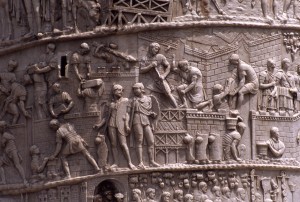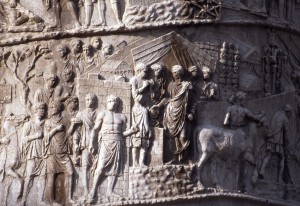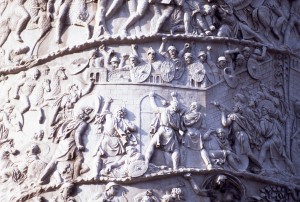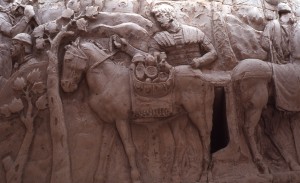The first phase of the Trajan’s Column Online Project concentrates on providing a searchable image archive and human figure catalogue for the helical frieze. These are accessed through the Search Column link. The ‘unrolled’ shaft drawing on the right has hot Scene numbers which take you directly to Scene drawings with numbered human figures. At the bottom of the individual scene page you can ‘Zoom out’ to acquire Conrad Cichorius’ plate coverage and general views. Some Cichorius plates cover more than one Scene so move around a bit between Scenes. ‘Zoom in’ to access detailed images of human figures. ‘Overlapping’ will give you images overlapping across Cichorius Scenes.
Drawings of the helical frieze were first fully published by Santi Bartoli (1672), and the first photographic coverage of casts of the frieze appeared in Froehner’s folio (1872-74). However, the first full and systematic description and commentary on the relief content was that of Conrad Cichorius (1896-1900).
Cichorius used two numbering systems as a frame of reference, the individual cast sections (1-414) and his ‘Scenes’ (I-CLV). The latter were defined by the appearance of clear divisions in the ‘action’ of the frieze, most obviously the use of vertical trees to defined discrete subjects, but also architecture and abrupt changes of direction in movements of human figure groups. Occasionally these divisions are contestable (see Gauer 1977), but they have been employed by scholars now for over a century, so they provide the structure for the website referencing. Cichorius used upper case Latin numerals for Scenes and this is followed in the website essays, but these do not work for numerical labling and sorting of images, so elsewhere Arabic numbers are used.
The Cichorius scenes were characterized as less historical/narrative and more generic in their content by Karl Lehmann-Hartleben (1926). These may be defined as follows: imperial speech (adlocutio), army march, construction activity, sacrifice (suovetaurilia etc.), open battle, siege, submission, ‘historical’, topographical, unidentifiable.
The individual ‘human’ figures (including deities) which populate the Cichorius Scenes are a key to understanding many aspects of the Column project, such as the organization and execution of sculptural work, and the roles of different types of people in the pictorial presentation of victory and defeat in Trajan’s Dacian Wars. Hairstyles, clothing, armour and function define these figures as different types of deities, Roman soldiers, barbarians and civilians. The 2,662 humans fall into twenty ‘Figure Types’, with just a small number (54) unattributable due to appearance as a head alone, or as a result of damage to the sculpture.
In each Cichorius Scene every human figure is assigned an Arabic number. Given that figures are intertwined in many convoluted scenes, especially battles, numbers are strictly applied to heads, from the viewer’s left to right and from bottom to top. Only very occasionally are heads not shown (e.g. XLI, LXX, XCIV, CXII pile of bodies) or lost through damage (e.g. CXXVI), but usually individuals can be counted with near certainty.
Thus every figure is assigned a catalogue reference by Scene and figure number: the figure of the Dacian king, Decebalus, committing suicide is Scene CXLV, figure 11 (145.11). Previous attempts at figure enumeration for Trajan’s Column (Koeppel 1991; 1992) and the Column of Marcus Aurelius (Petersen et al. 1896) did not apply numbers in a spatially logical progression.
This website also presents supporting essays which explore aspects of the monument’s creation, history, relief content, monumental context and post-Trajanic ‘life’. These may be accessed through ‘The Project’ page right menu.
Every Scene of the helical frieze has a drawing with figure numbering. Use ‘Search Column’ for drawing and searchable figure catalogue. Use ‘Zoom in’ to access a Cichorius image of the Scene. This also provides the general photographic images in the archive. Images of all the individual figures will be provided at a later stage of the project, but all are covered in the images already posted. Use ‘Overlap’ to view images linking across Scenes. More images of individual figures will be added as additional funding to support work becomes available.
The next phase will be coverage of the pedestal reliefs. General views of the Column exterior, internal images, and material relating to the Column’s monumental context within the Forum of Trajan will also be added (‘Other Monuments’). These are also intended as a freely available teaching aid for the sort of modules presented by Jon Coulston in the University of St Andrews, Scotland (The Roman Army; Roman Imperial Art; The Ancient City of Rome). Themed bibliographies of secondary literature pertain to study of the Column and related issues (‘Bibliographies’). Jon Coulston’s own published articles in this field are made available as pdfs (‘Articles’). A forum is set up for viewers interested in discussing Column studies (‘Community’).
This is one of a number of websites dedicated to Trajan’s Column, constructed by people with a range of special interests, which are splendidly complementary, covering as they do different aspects and special interests (‘Links’). They provide photographic coverages which are very different in generation, lighting and presentation.
References
Cichorius, C. 1896-1900: Die Reliefs der Traianssäule, Berlin, II 1896, III 1900
Froehner, W. 1872-74: La Colonne Trajane, Paris
Gauer, W. 1977: Untersuchungen zur Trajanssäule 1. Darstellungsprogramm und künstlerischer Entwurf, Monumenta Artis Romanae, herausgegeben von Forschungsarchiv für römische Plastik am archäologischen Institut der Universität in Köln 13, Berlin
Lehmann-Hartleben, K. 1926: Die Trajanssäule. Ein römisches Kunstwerk zu Beginn der Spätantike, Berlin
Santi Bartoli, P. 1672: Colonna Traiana, eretta dal Senato e Popolo Romano all’imperatore Traiano Augusto nel suo foro in Roma, Roma












